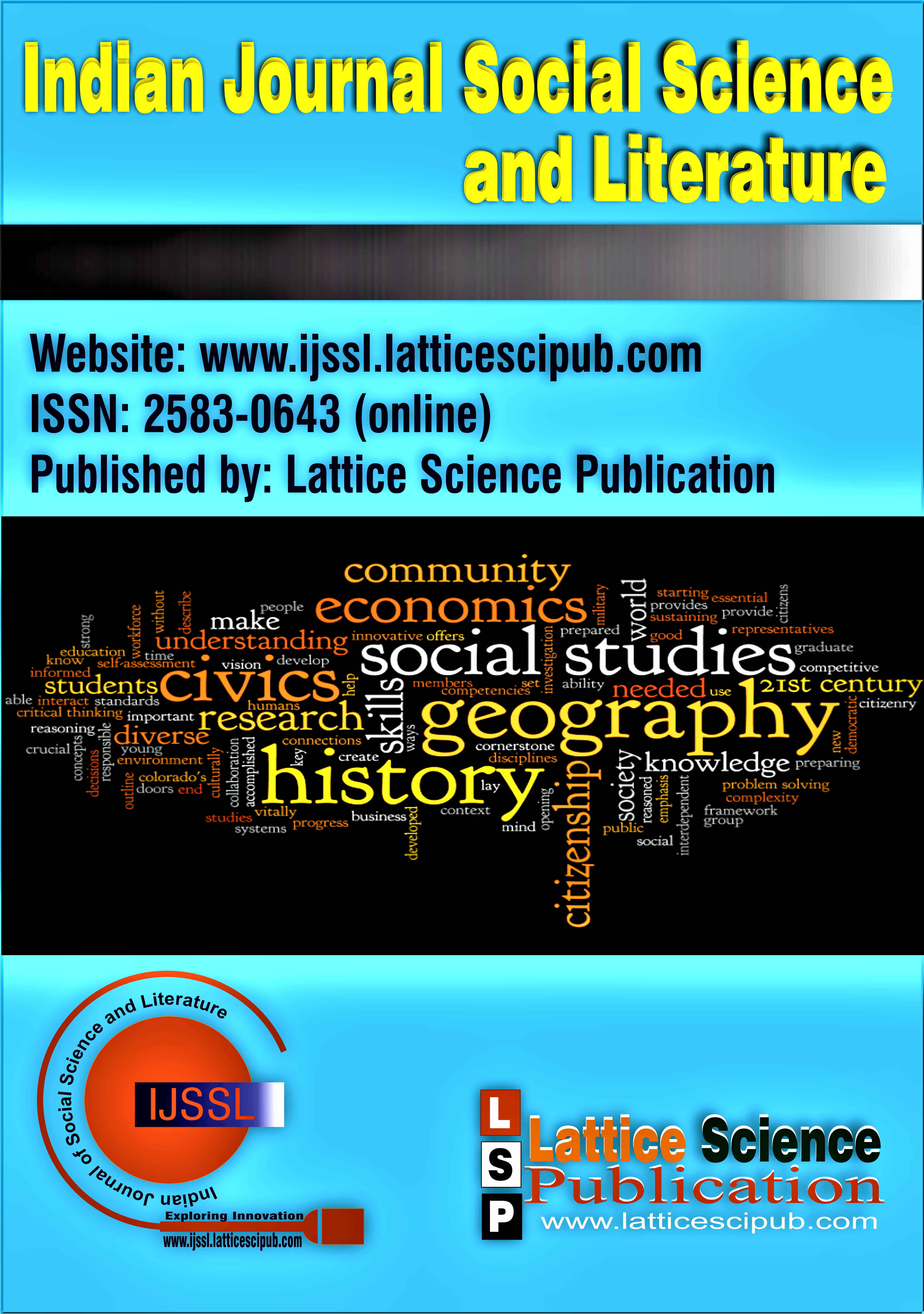Displaying the Human’s Struggle Against Oppression: An Examination of Eugene O’Neill’s “The Hairy Ape”
Main Article Content
Abstract
To assert the predominant fact, which insist the core function of drama as being the tool of informing stories and writing process as the creation of those stories. Eugene O’Neill firmly determined to devote his writing to be a mirror to reflect his experiences and the society he belonged to. Within socio-economic circumstances, Eugene O’Neill has depicted the culture of the injustice community of the 1920s in America. His characters were routinely qualified of creating human’s experiences and statuses onstage. Moreover, O’Neill’s plotline was motivated by the power of contemporary people to depict their agony, oppression, and misery. So as to achieve this end, Eugene O’Neill wrote “The Hairy Ape”, as dehumanizing impactsof industrialization to describe the oppression of the protagonist; Yank, who was impacted by the social background of oppressing American capitalist system in a so-called modern community. Harmoniously, as many of O’Neill’s literary plays focused, the selected drama for this study concentrated on the struggle of life, identity, and relation in modern America. This research aims to organize and arrange the beginnings of a description for the complicated idea of human oppression in dramatic products. The concept of ‘oppression’ has so used, so frequently, and so large today, that clarifying it meant discovering an illustration of more elaborated than any dictionary. The study adopted deductive perceptive to figure out many concepts of human oppression, but eventually utilized sociocultural oppression as the center for this research. Accordingly, social oppression presents agony or harm which were imposed on a plays’ character by their society or peers. The present paper has concluded that after analyzing in-depth to look at all characterizations of oppression and comprehending all Yank’s surrounded circumstancing, Yank as a victim and his principal oppressor were the his social class (his employment system and his educational experience) as well as the people surrounded him. Finally, the study has figured out a distinguished intellectual responsibility in the character of Yank.
Downloads
Article Details

This work is licensed under a Creative Commons Attribution-NonCommercial-NoDerivatives 4.0 International License.
How to Cite
References
Ali, M. (2019). O’Neil’s the hairy ape and insane society. International Journal of English Research. 3(5), 20-21.
AlTaher, B. (2016). A Modern Tragic Hero in Eugene O'Neill's The Hairy Ape. Arab World English Journal (AWEJ), Special Issue on Literature, (4), 224-231. [CrossRef]
Azizmohammadi, F. (2022). CONCEPT OF MAGICAL REALISM IN THE HAIRY APE PLAY BY EUGENE O’NEIL IN THE LIGHT OF GABRIEL GARCIA MARQUEZ’S THEORY. PalArch's Journal of Archaeology of Egypt/Egyptology, 19(1), 977-990.
Baqer, Z. A. (2010). The Spiritual Vacuum and the Need for Belonging in Eugene O'Neill's The Hairy Ape. Journal of University of Babylon, 18(3).
Brugnoli, A. (2012). Eulogy of the Ape: paradigms of alterity and identity in Eugene O'Neill's The Hairy Ape. The Eugene O'Neill Review, 33(1), 43-55. [CrossRef]
Cardullo, R. J. (2015). O’Neill’s The Hairy Ape in Relation to Greek Tragedy, Italian Futurism, and Divine Comedy. In A Play Analysis (pp. 67-78). SensePublishers, Rotterdam. [CrossRef]
Clare, I. B. D. (2020). James Light: Notes on Staging Eugene O'Neill's The Hairy Ape/Cover Letter to HM Harwood (1926). The Eugene O'Neill Review, 41(1), 18-30. [CrossRef]
Dang, C. (2019). Struggling between Ancient and Modern Life: Yank's Quest of Self-identity in The Hairy Ape. Theory and Practice in Language Studies, 9(1), 112. [CrossRef]
Farhoudi, H., & Zolfaghari, Y. (2014). Under the shade of ideology: a Marxist study of Eugene O'Neill's the Hairy Ape. The Eugene O'Neill Review, 35(2), 161-176. [CrossRef]
Hahl, V. A. (2008). Making victim: Establishing a framework for analyzing victimization in 20th century American theatre. University of Central Florida.
JIANG, Y. (2021). Study on the Dionysian Spirit of Yank in The Hairy Ape. Studies in Literature and Language, 22(3), 34-40.
Krishnaveni, N., & Khan, S. (2019). A STUDY OF THEME AND TECHNIQUE IN EUGENE O’NEILL’S THE HAIRY APE. INNOVATIVE RESEARCH ON ENGINEERING, SCIENCE, PHARMACY, HUMANITIES AND MANAGEMENT (ICIR-2019), 165.
Mahuvakar, H. (2015). The Search for Belonging in Eugene O’Neill’s Play ‘The Hairy Ape’. International Journal of Research and Analytical Reviews. 21(4), 68-71.
McKnight Jr, H. W. (2012). The Black O'Neill: African American Portraiture in Thirst, The Dreamy Kid, Moon of the Caribbees, The Emperor Jones, The Hairy Ape, All God's Chillun Got Wings, and The Iceman Cometh (Doctoral dissertation, Ohio Dominican University).
Murphy, D. (2018). An American Futurism? Corporeal History in O'Neill's The Hairy Ape and Santell's Film Adaptation. The Eugene O'Neill Review, 39(1), 114-133. [CrossRef]
Nastić, R. (2015). Trauma and the Tragic in The Hairy Ape and All God's Chillun Got Wings. The Eugene O'Neill Review, 36(2), 194-211. [CrossRef]
Nezhad, Z. Y., & Ahmadian, M. (2012). A Comparative Analysis Between The Hairy Ape and Emperor Jones by Eugene O'Neill from Expressionism Viewpoint. Mediterranean Journal of Social Sciences, 3(11), 197-197.
O’Neill, Eugene. (2010). The Hairy Ape. Delhi: Surjeet Publication, Seventh Reprint.
Paramagururaj, S., & Ganesan, A. (2019). The Elements of Existentialism in Eugene O’Neill’s Play The Hairy Ape: A Study. Sri S. Ramasamy Naidu Memorial College Sattur 626203, Tamilnadu, India, 20.
Posner, D. N. (2018). America and the individual: The hairy ape and Machinal at the Moscow Kamerny Theatre. New Theatre Quarterly, 34(1), 3-15. [CrossRef]
Qian, X. (2020). Highlight of the Tragic Theme of" The Hairy Ape" by Expressionist Techniques. In 2020 Conference on Education, Language and Inter-cultural Communication (ELIC 2020) (pp. 577-581). Atlantis Press. [CrossRef]
Sadoon, M. M. (2010). Grammatical Deviations in O'Neill's Hairy Ape. Adab Al-Kufa, 1(6).
Sah, B. (2019).The Hairy Ape: A Tragic Dilemma of Belonging. Strength for Today and Bright Hope for Tomorrow Volume 19:ISSN 1930-2940, 131, 62.
Schaber, B., & Bahroun, A. (2019). Two Photoplays by Eugene O'Neill: The Hairy Ape and Desire Under the Elms, November 1926. The Eugene O'Neill Review, 40(1), 1-9. [CrossRef]
Zaniboni, K. (2013). An Examination Of The Actor's Approach To Playwriting: Are Playwrights Able To Write About What Is Unfamiliar To Them?





